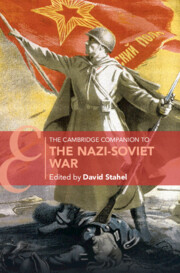Refine search
Actions for selected content:
33 results
3 - Stalin’s Political Delusions and Military Preparations for War with Nazi Germany
- from Part I - Conceptions of War
-
-
- Book:
- The Cambridge Companion to the Nazi-Soviet War
- Published online:
- 13 November 2025
- Print publication:
- 20 November 2025, pp 45-64
-
- Chapter
- Export citation
5 - The Red Army: Leadership and Command
- from Part II - Opposing Forces
-
-
- Book:
- The Cambridge Companion to the Nazi-Soviet War
- Published online:
- 13 November 2025
- Print publication:
- 20 November 2025, pp 90-103
-
- Chapter
- Export citation
18 - The Big Three and the Eastern Front
- from Part VI - Comrades in Arms
-
-
- Book:
- The Cambridge Companion to the Nazi-Soviet War
- Published online:
- 13 November 2025
- Print publication:
- 20 November 2025, pp 329-346
-
- Chapter
- Export citation
1 - German-Soviet Relations and Military Collaboration in the Inter-war Period
- from Part I - Conceptions of War
-
-
- Book:
- The Cambridge Companion to the Nazi-Soviet War
- Published online:
- 13 November 2025
- Print publication:
- 20 November 2025, pp 9-26
-
- Chapter
- Export citation
20 - The Politics of War Memory in the USSR and Post-Soviet Russia
- from Part VII - Post-war Legacies and Myth-Making
-
-
- Book:
- The Cambridge Companion to the Nazi-Soviet War
- Published online:
- 13 November 2025
- Print publication:
- 20 November 2025, pp 365-381
-
- Chapter
- Export citation
12 - The Berlin Crises
- from Part IV - The Nuclear Era
-
- Book:
- Crises, War, and Diplomacy
- Published online:
- 07 November 2025
- Print publication:
- 20 November 2025, pp 243-269
-
- Chapter
- Export citation

The Cambridge Companion to the Nazi-Soviet War
-
- Published online:
- 13 November 2025
- Print publication:
- 20 November 2025
Chapter 4 - The Second World War
- from Part I - Key Places and Events
-
-
- Book:
- Sean O'Casey in Context
- Published online:
- 23 June 2025
- Print publication:
- 10 July 2025, pp 45-56
-
- Chapter
- Export citation
11 - Building a Totalitarian Regime
-
- Book:
- Institutional Genes
- Published online:
- 03 June 2025
- Print publication:
- 26 June 2025, pp 499-542
-
- Chapter
- Export citation
10 - Building China’s Bolshevik Party
-
- Book:
- Institutional Genes
- Published online:
- 03 June 2025
- Print publication:
- 26 June 2025, pp 449-498
-
- Chapter
- Export citation
8 - The Birth of Bolshevik Totalitarianism
-
- Book:
- Institutional Genes
- Published online:
- 03 June 2025
- Print publication:
- 26 June 2025, pp 315-391
-
- Chapter
- Export citation
30 - The Allies and the Holocaust
-
-
- Book:
- The Cambridge History of the Holocaust
- Published online:
- 16 May 2025
- Print publication:
- 12 June 2025, pp 498-513
-
- Chapter
- Export citation
Chapter 5 - Manipulating Statistics and Statisticians
-
- Book:
- Politicians Manipulating Statistics
- Published online:
- 31 May 2025
- Print publication:
- 03 April 2025, pp 91-121
-
- Chapter
- Export citation
2 - The Bolsheviks and Oil
-
- Book:
- Fuel and Power
- Published online:
- 13 June 2024
- Print publication:
- 27 June 2024, pp 31-70
-
- Chapter
- Export citation
4 - Stalin in Asia
- from Part I - Ambition
-
- Book:
- To Run the World
- Published online:
- 30 May 2024
- Print publication:
- 30 May 2024, pp 111-142
-
- Chapter
- Export citation
1 - The Postwar World
- from Part I - Ambition
-
- Book:
- To Run the World
- Published online:
- 30 May 2024
- Print publication:
- 30 May 2024, pp 17-38
-
- Chapter
- Export citation
Chapter 4 - Translations
-
- Book:
- Persianate Verse and the Poetics of Eastern Internationalism
- Published online:
- 14 December 2023
- Print publication:
- 21 December 2023, pp 131-164
-
- Chapter
- Export citation
“Basically, it’s a History of the Russian State”: Russocentrism, Etatism, and the Ukrainian Question in Stalin’s Editing of the 1937 Short History of the USSR
-
- Journal:
- Nationalities Papers / Volume 53 / Issue 2 / March 2025
- Published online by Cambridge University Press:
- 18 December 2023, pp. 298-317
-
- Article
-
- You have access
- Open access
- HTML
- Export citation
4 - State Sovereignty
- from Part I - Ordering Concepts
-
-
- Book:
- Peacemaking and International Order after the First World War
- Published online:
- 18 May 2023
- Print publication:
- 01 June 2023, pp 91-113
-
- Chapter
- Export citation
19 - Indian Summer or Conservative Winter?
-
-
- Book:
- The Cambridge Companion to Winston Churchill
- Published online:
- 19 January 2023
- Print publication:
- 26 January 2023, pp 379-395
-
- Chapter
- Export citation
